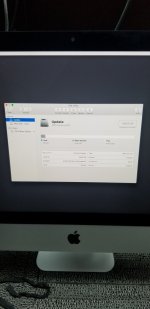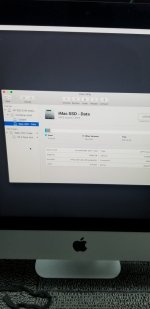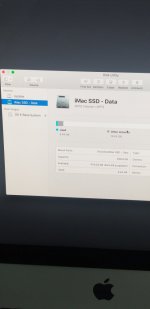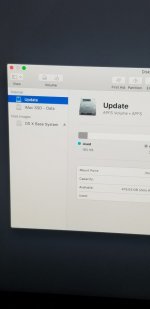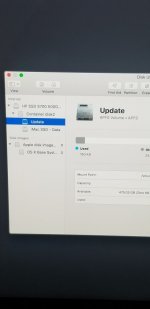Thanks for the images. First, a bit of a tutorial so we can talk about it. My apologies if you already know this, but it is key to be able to talk about the images. In the new APFS structure that started with High Sierra, Apple did away with the use of "partition" for the most part. You still CAN partition a hard drive, but most of us don't anymore. The reason is the second thing Apple did was in APFS it creates what are called "Containers" on the drive. You can see that in the image 2022125_133207.jpg file. The hardware is on the top line, where it says "HP SSD..." That is the physical device. Then there is one Container named "Container disk2" and inside that Container are two Volumes, one named "Update" and the other named "iMac SSD - Data." Normally, when you format the drive you give it a name and that name then is used for one of the Volumes the installation creates and is used as part of the name for the second Volume the installation creates. So, for example, if I were to reformat that SSD and give it the name "MacInWin," I would expect to see the hardware line stay the same, the Container line stay pretty much the same, except that the "disk2" may change as it depends on where it is mounted, and then there would be two Volumes, one named "MacInWin" and the other "MacInWin - Data." Then when the installer installs macOS, it puts the system files on the "MacInWin" volume and the user data on the "MacInWin - Data" Volume. The first Volume is read-only, possibly encrypted and secure to keep out malware, the second is read/write and contains everything all of the user accounts can get at to read and write, including Applications. Technically, the /System, /Applications and /Library folders are on "MacInWin" and /Users is on the "MacInWin - Data" Volume.
OK, with that information, and looking at your images, what is missing is the Volume that should be named "iMac SSD" to go with the "iMac SSD - Data" Volume. It is possible that what you see as "Update" is the system Volume, but normally it would not be named "Update," but "as I said, "iMac SSD."
Let me ask, have you done any other deletions or changes to this drive other than install? Did you rename a drive, or reformat? It looks like you are booted into Recovery, so that tells me you can't boot into the boot Volume, if there is still one there.
I know you said everything was "fine until the system automatically added the second volume which is labeled Update," but what does that really mean? When done properly, the two Volumes in my example would be merged logically by Finder to show as one single logical drive called "MacInWin" on my Desktop and in Finder. And it would act as a single drive. But your two Volumes have unrelated names, which may or may not be why they are mounting separately. The OS can't merge them as it should.
Drives don't usually name themselves. Did you give the name "Update" at any point in the formatting of the SSD? In the installation of the OS?
What others have done, by mistake, is to force the installation to one particular Volume, thinking it is like a partition, then ending up with multiple Data Volumes because each installation re-created a new Volume and named it Data. I don't see that in your images, but wanted to warn you to be careful about that, too.
Frankly, at this point it may be best to just erase the entire drive at the hardware level and let it recreate the Container and Volumes, then install the OS to the Container and let it create the Volumes it needs. That action will delete ALL of the data on the drive, so you will need a backup to get your own data back using Migration Assistant once the new SSD is bootable.



